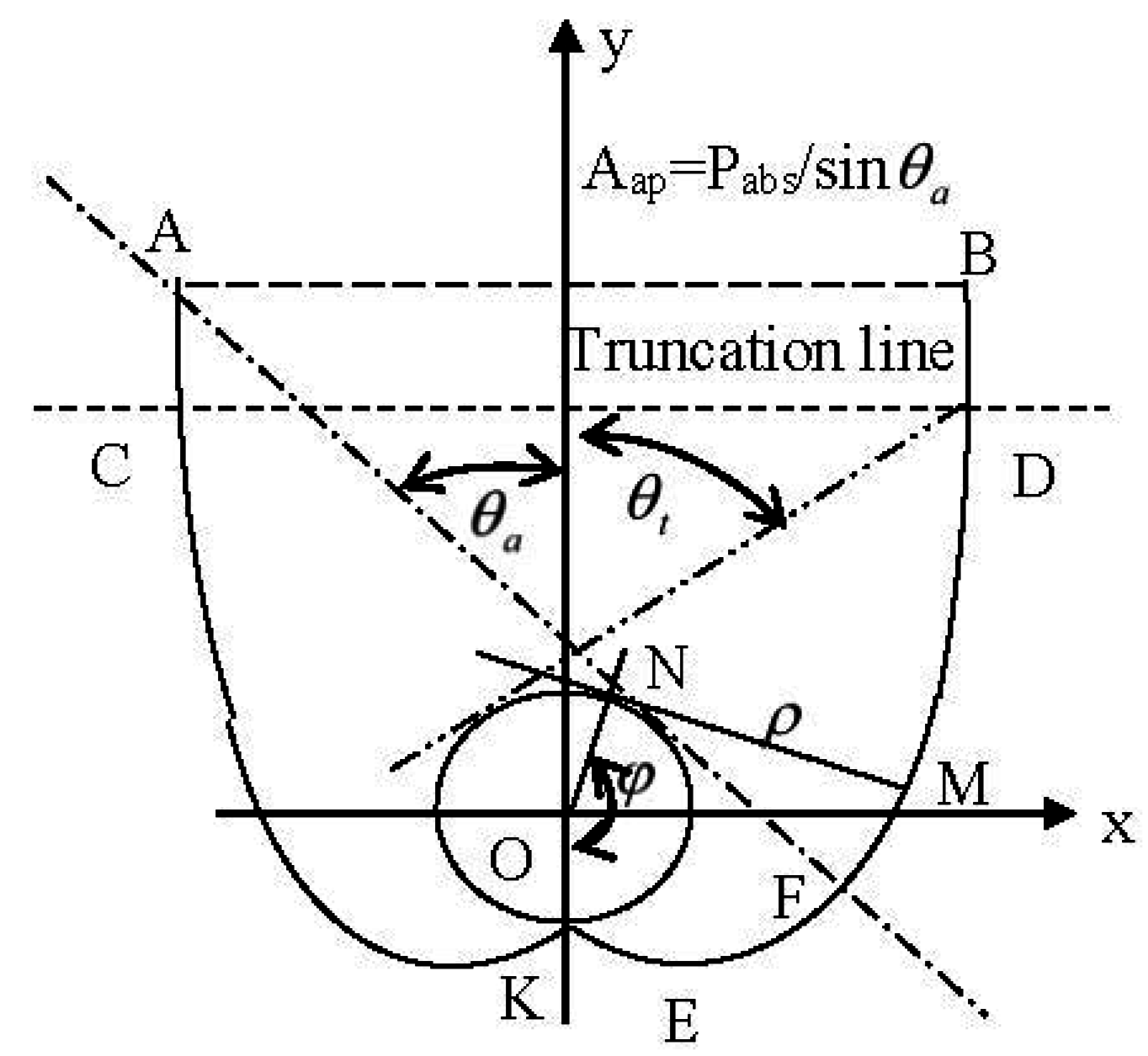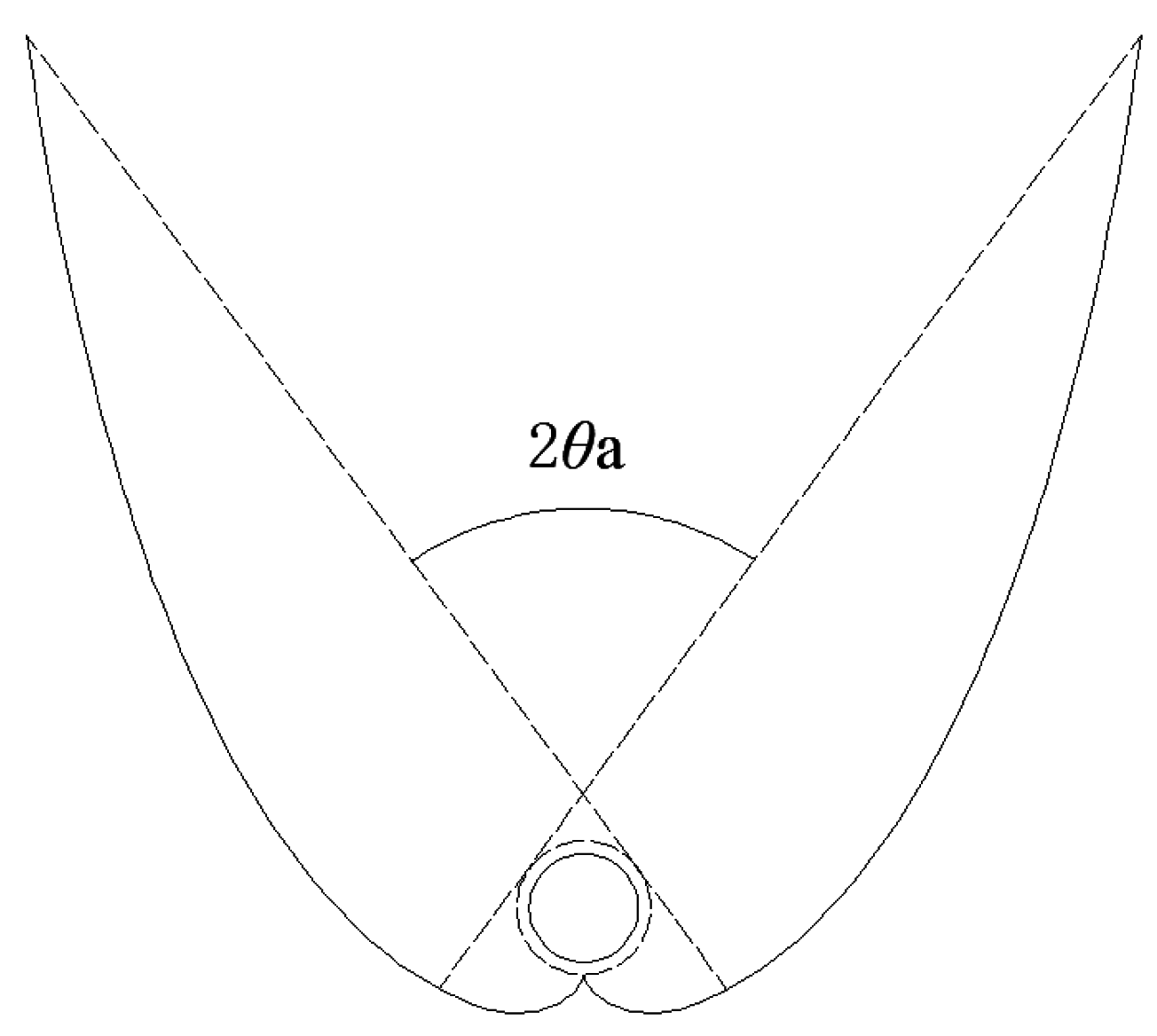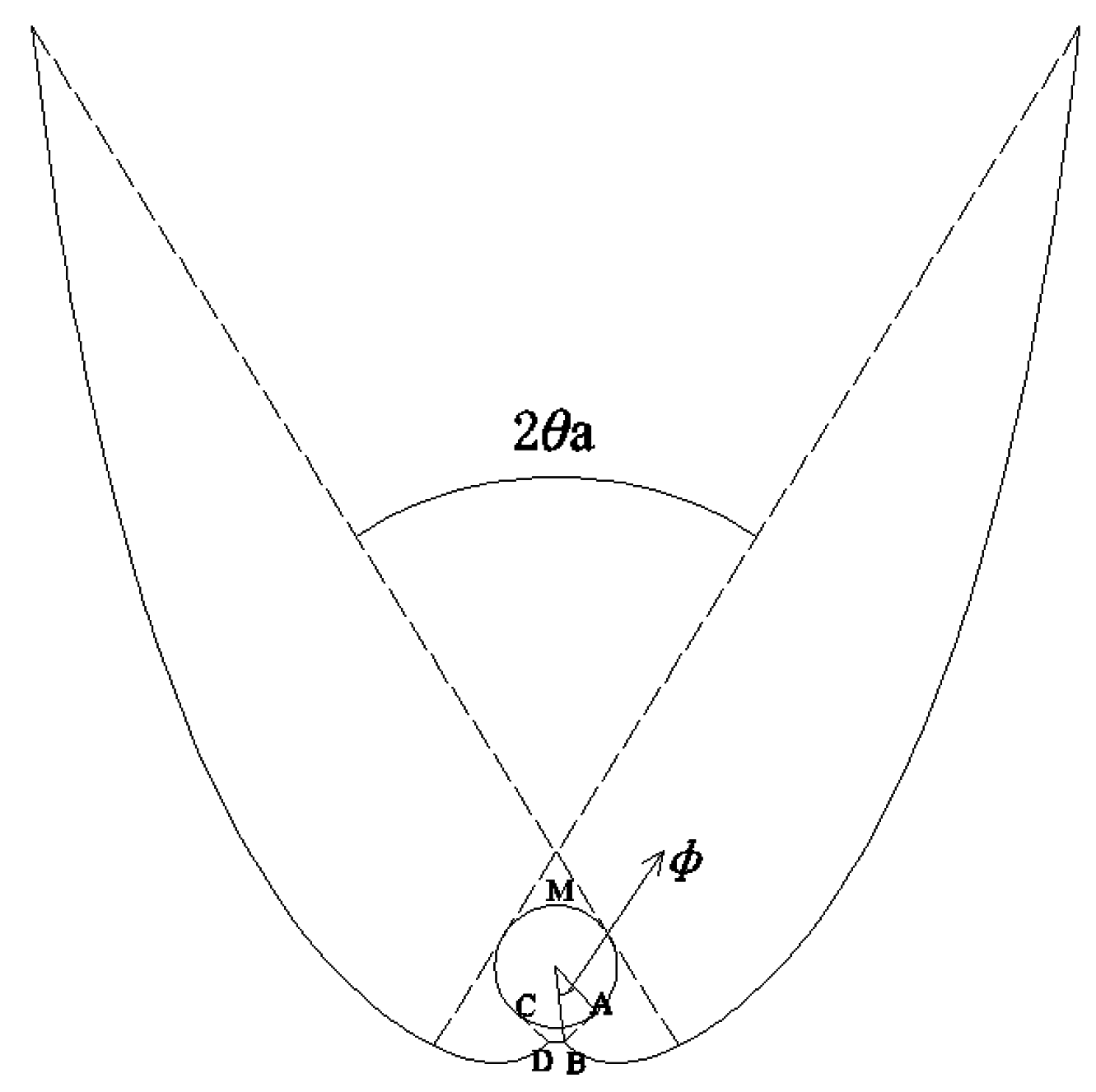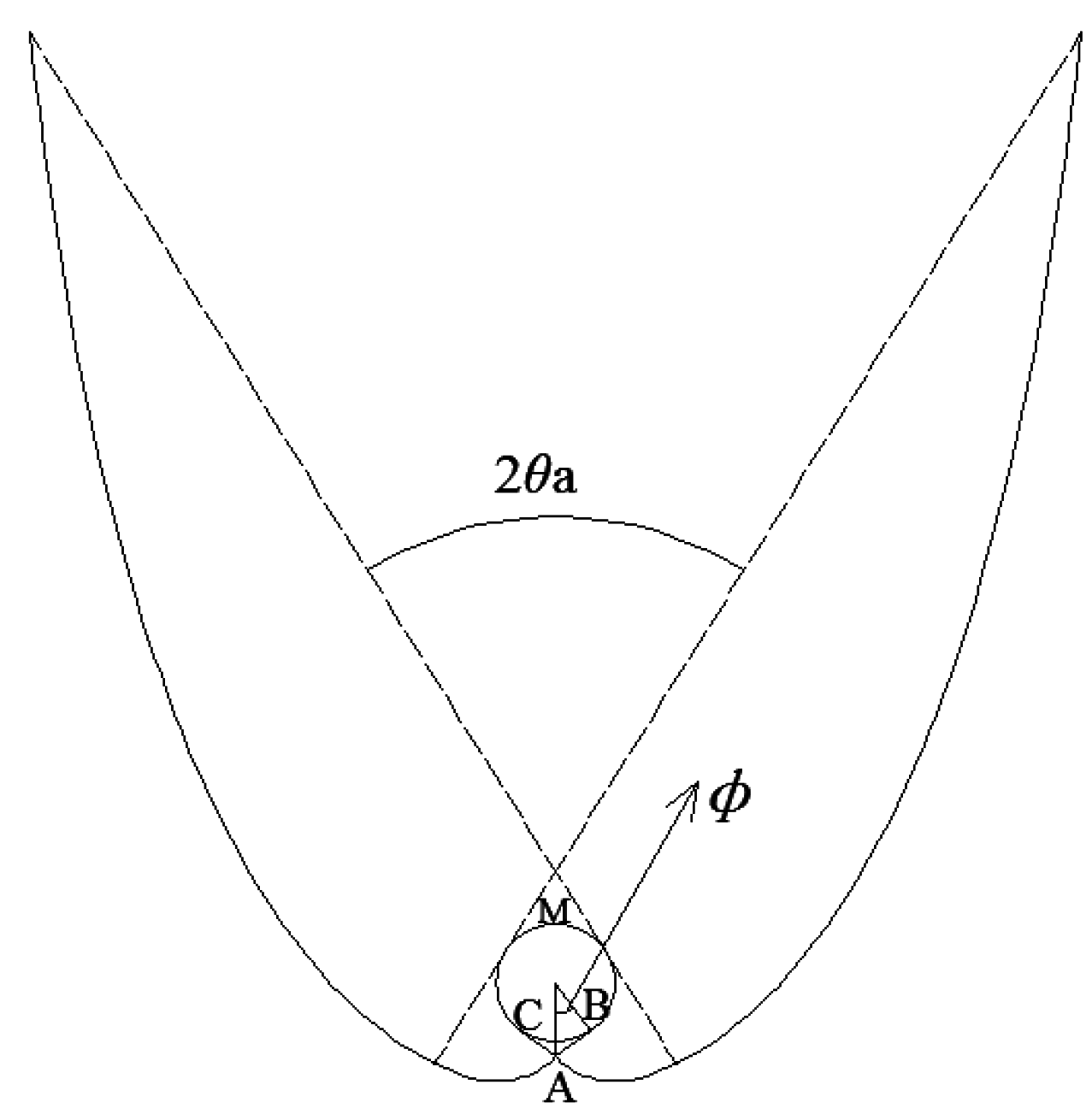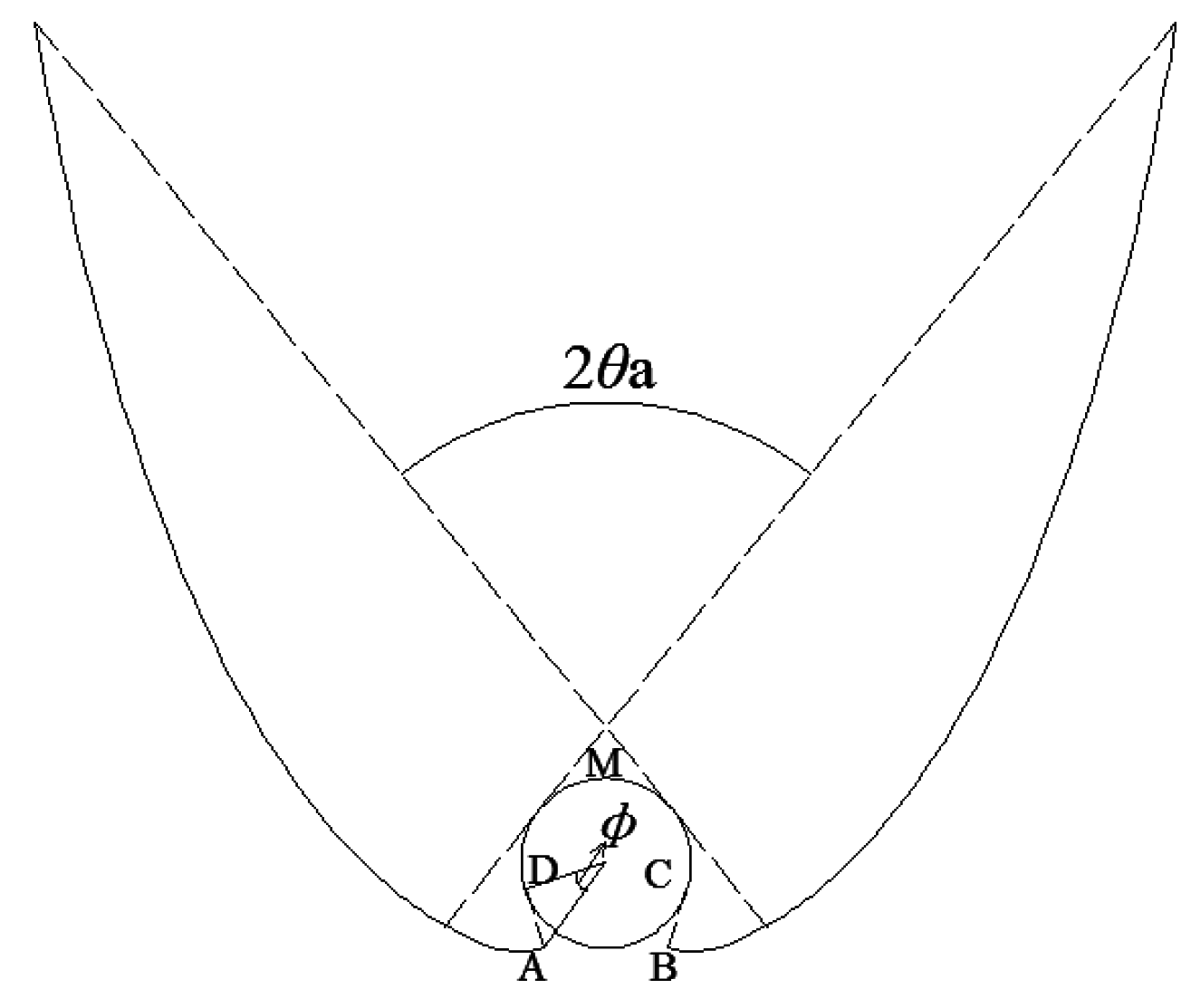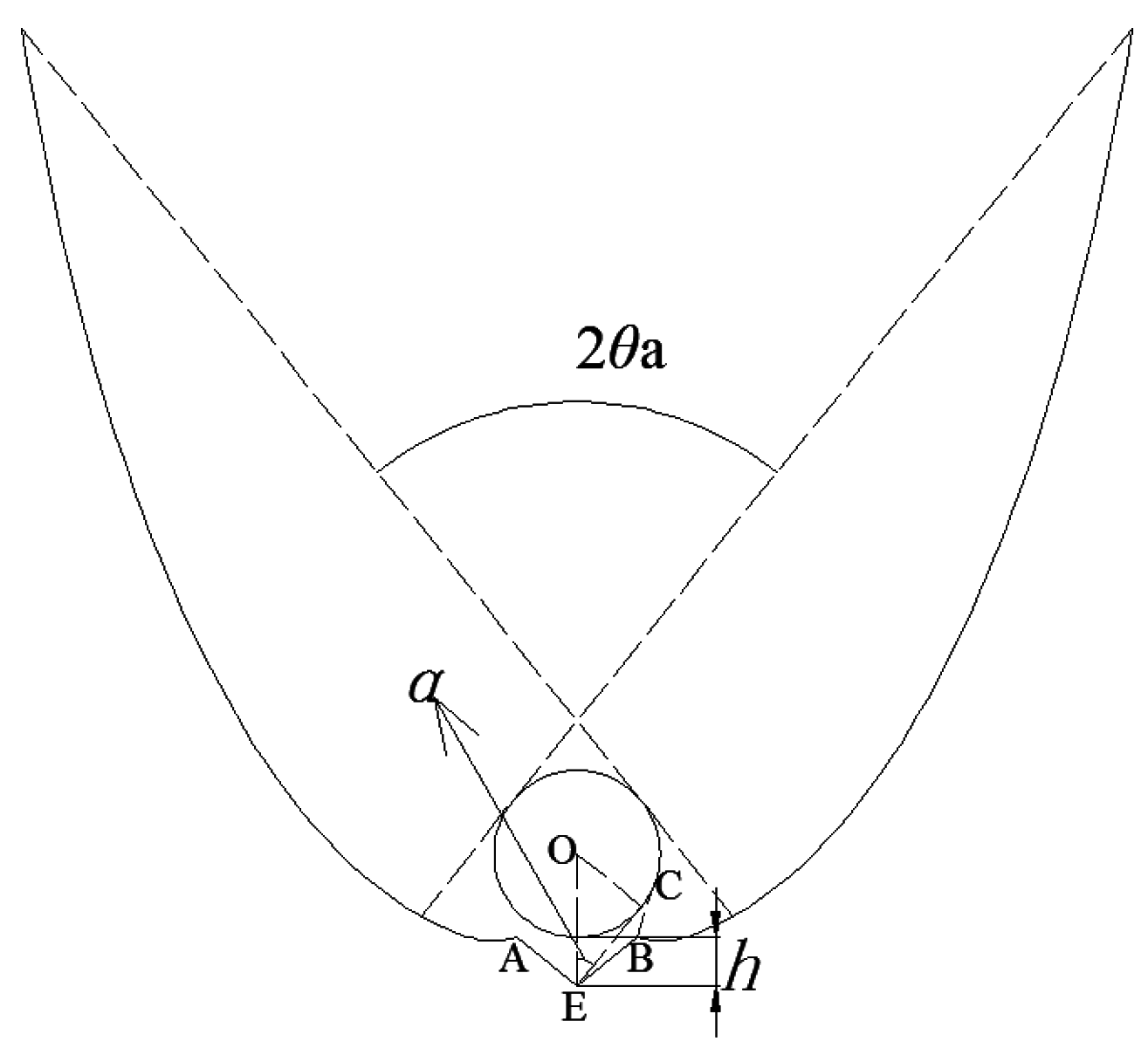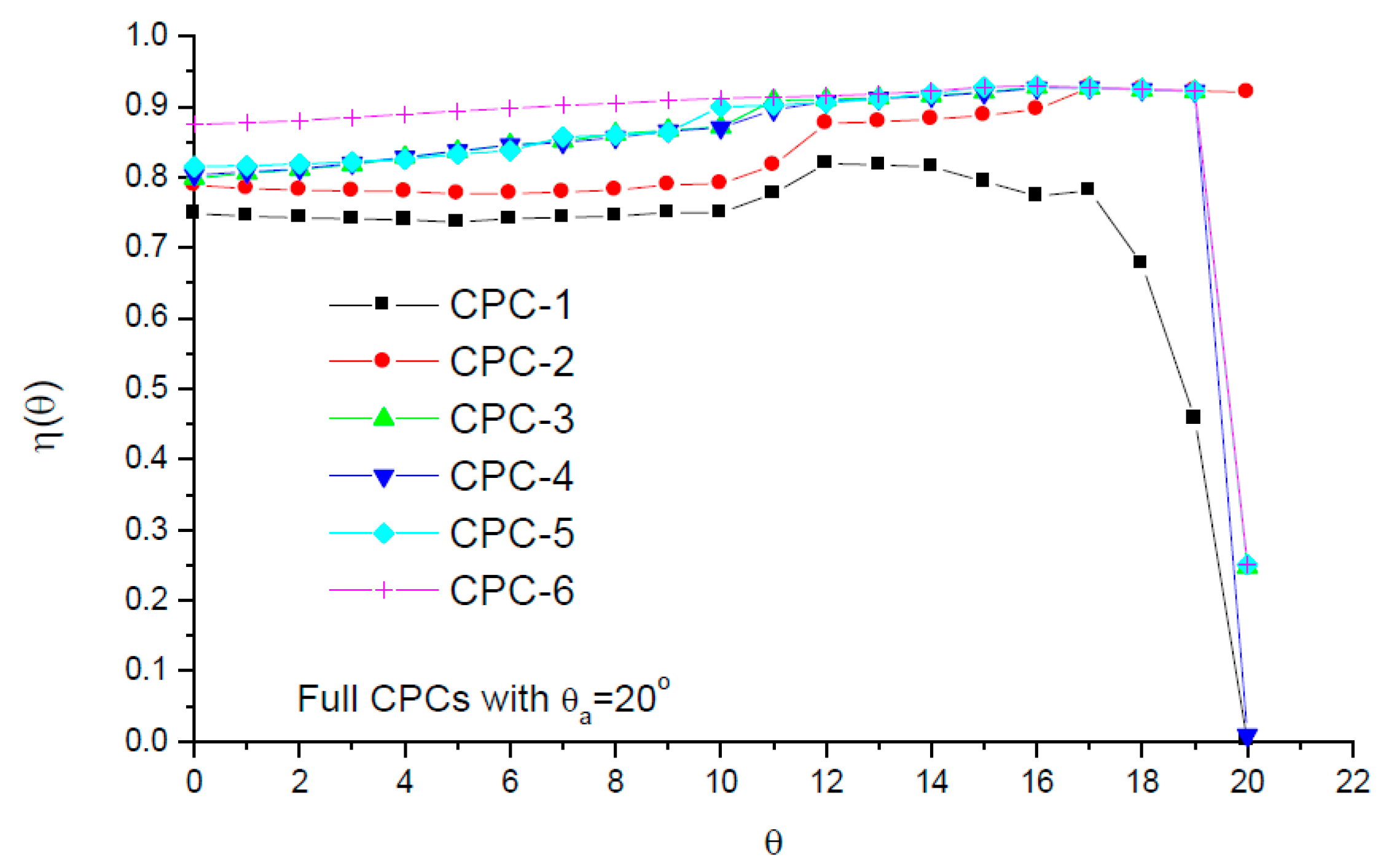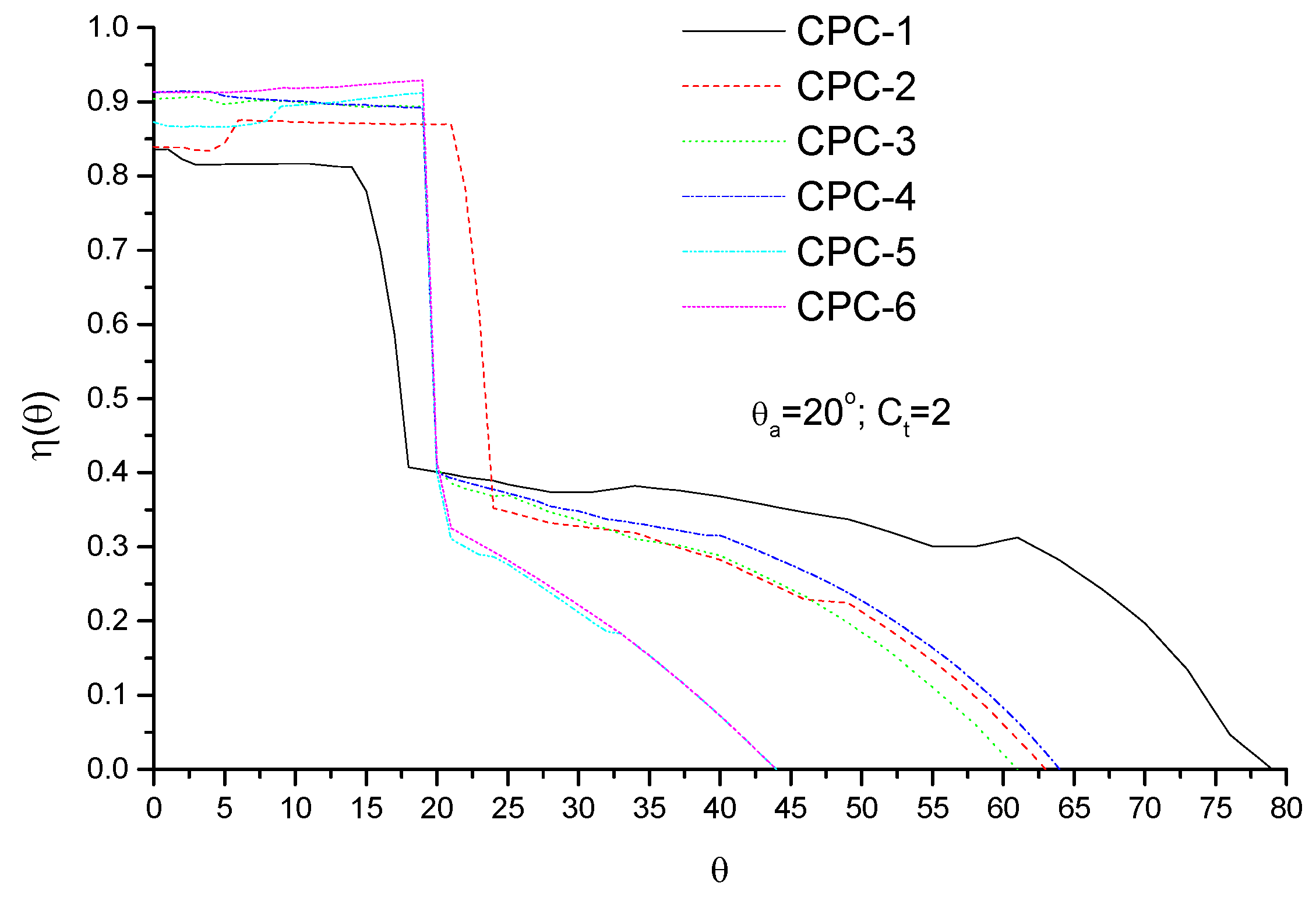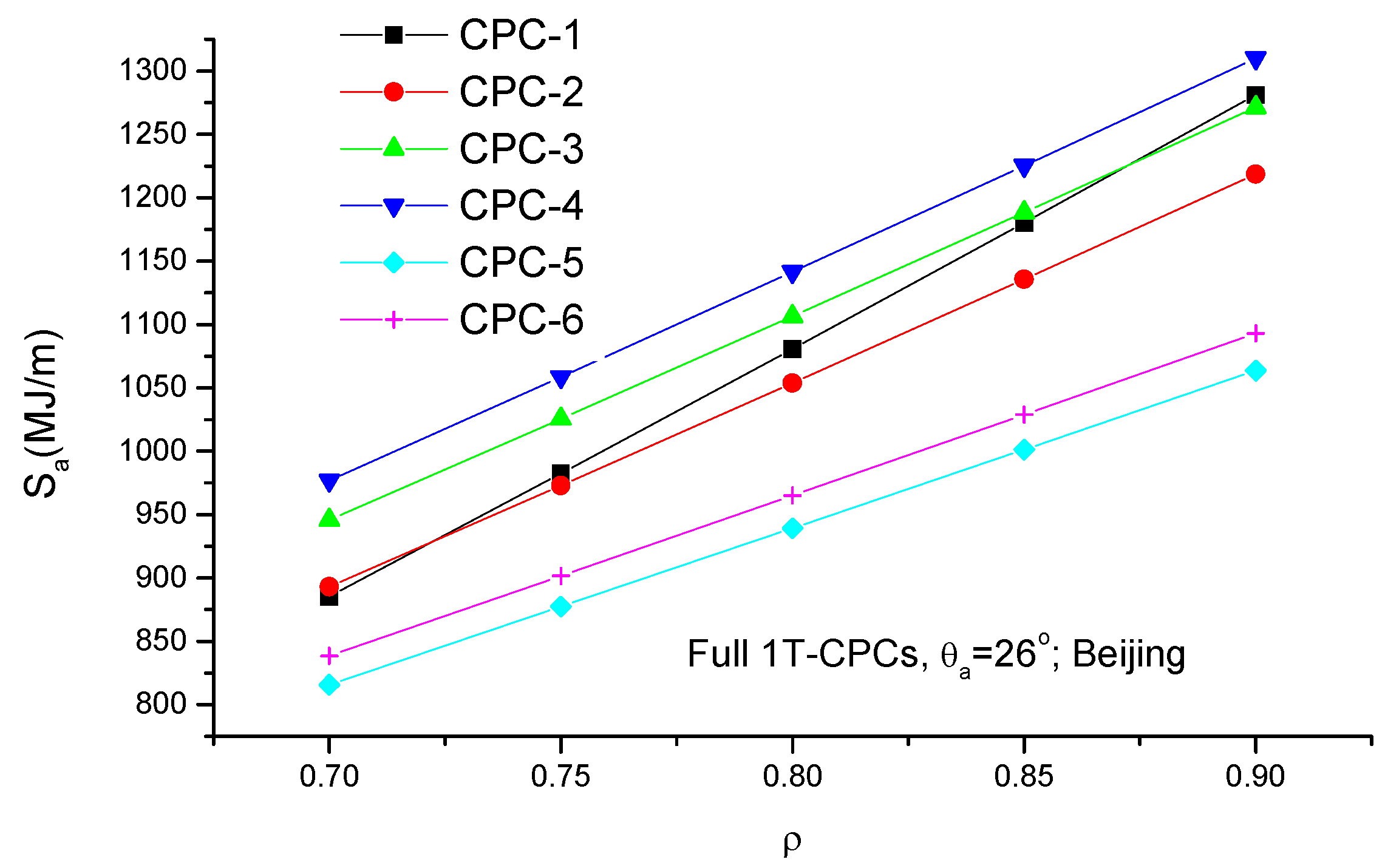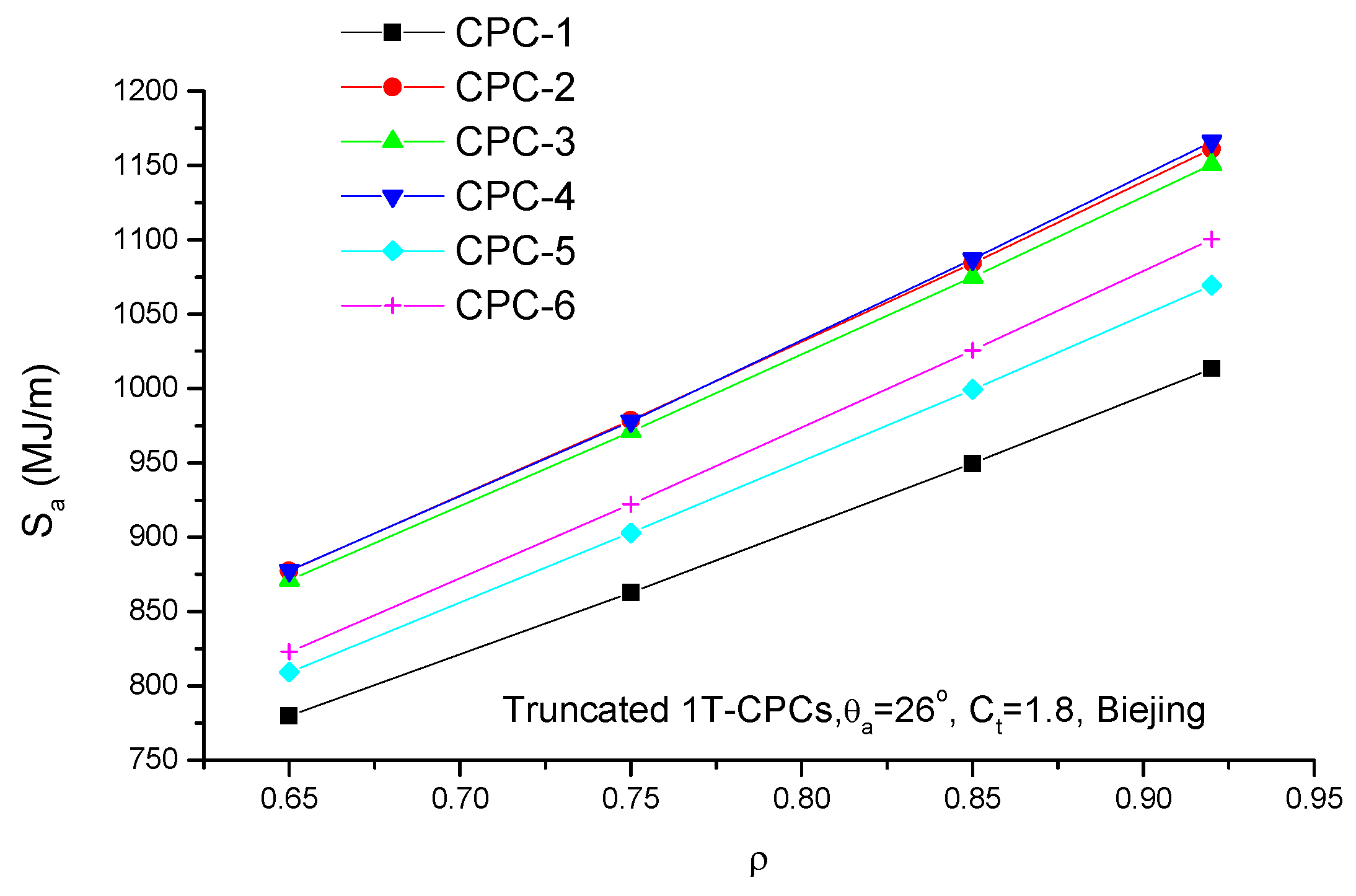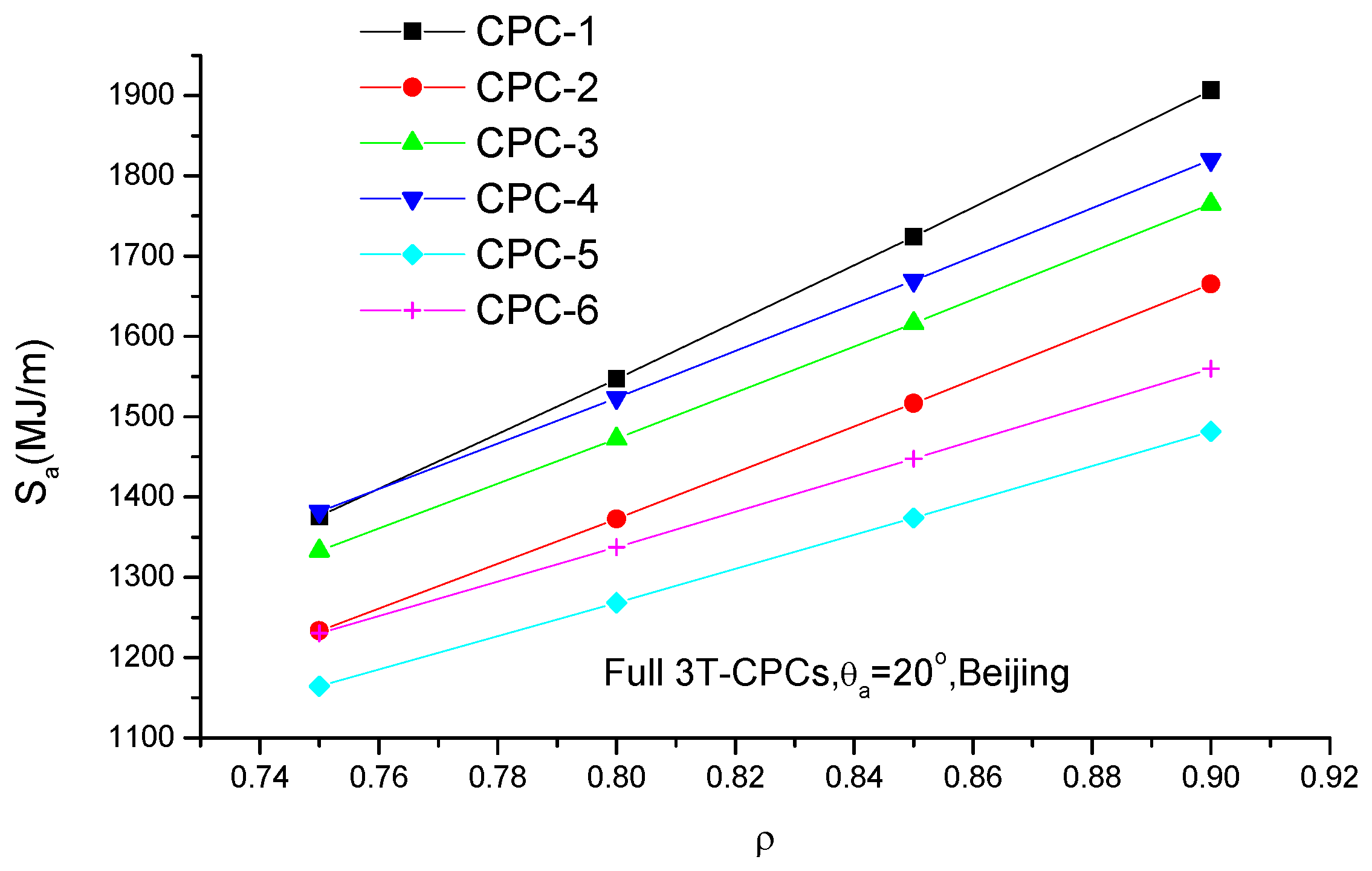2.1. Geometry of Compound Parabolic Solar Concentrator with a Tubular Absorber
As shown in
Figure 1, any point
M on the reflector of CPC can be described in two parameters:
(formed by lines from the origin O to K and N) and
=
MN (the line tangent to the absorber tube at N). Thus, in the suggested coordinate system as shown in
Figure 1, the (right) reflector of CPC constructed based on a tubular absorber is expressed by:
The reflector of such CPC includes involute (0 ≤
≤ 0.5π + θ
a) and upper reflector (0.5π + θ
a <
≤ 1.5π – θ
a), and one can derive the expression of
from the string method as follows:
The
r in above expressions is the radius of the tubular absorber. The geometrical concentration of an ideal CPC, the ratio of aperture width (
Aap) to the perimeter (
Pabs,d) of absorber based on which the reflectors of CPC are constructed, is uniquely determined by its acceptance half-angle (θ
a) and is given by:
and:
In practical application, the upper part of reflectors is usually truncated to save reflector materials and reduce the depth of CPC due to the lesser contribution of upper reflectors to the solar radiation concentration, and the geometrical concentration in this case can be found by substituting
= 1.5π – θ
t into Equations (1) and (2) as follows:
and the depth of the truncated CPC is given by:
where θ
t is the edge-ray angle of CPCs after truncation (
Figure 1), and θ
t = θ
a for full CPCs. The last term “0.5π
r” in Equation (6) is the vertical depth of lowest point (
= 0.5π, a point on the involutes corresponding to d
y/d
x = 0) of reflectors relative to the
x-axis. In turn, given
Ct and θ
a, the edge-ray angle (θ
t) can be obtained from Equation (5) by iterative calculations.
It must be noted that all CPCs with EST as the receiver are not ideal solar concentrators as mentioned above, and the geometrical concentration factor is the ratio of aperture width (Aap) to the perimeter of the actual solar absorber (i.e., the inner tube of EST, Pabs,a = 2πr) which might differ from Pabs,d as seen in the next section.
2.2. Design of Compound Parabolic Solar Concentrator with All-Glass Evacuated Tube as the Receiver
The EST measuring 47/58 mm in diameter of inner tube/cover tube, the one of the most common solar products in the market, is considered in this work. Based on the string method of reflector construction of CPCs [
18] and geometric characteristics of EST [
17], there are six symmetric CPCs most suitable for concentrating radiation on the EST as follows:
CPC-1: designed based on the cover tube (
Figure 2). The geometrical concentration of full CPC-1 is given by:
where
Pabs,d is the perimeter of cover tube (2π
R) instead of 2π
r because CPC-1 is designed based on the cover tube of EST. In this case, the
r in Equation (1) is set to be
R, and
in this case is given by:
Given θ
t and θ
a, the depth of CPC-1 is calculated by:
CPC-2: designed based on the inner tube of EST, but the EST is purposefully moved up
R-
r (
Figure 3). The geometry concentration of full CPC-2 is
Cg,2 = 1/sinθ
a due to
Pabs,d =
Pabs,a = 2π
r, and the
in Equation (1) is given by Equation (2).
CPC-3: designed based on inner tube of EST with reflectors (involutes) near the inner tube being truncated (
Figure 4). In this case,
Cg,3 = 1/sinθ
a, but the construction of involutes starts at point B of the cover tube (
Figure 4 ) with φ = ϕ, thus the
in Equation (1) is given by:
and the depth of CPC-3 is calculated from Equation (6).
CPC-4: designed based on “ice-cream” virtual receiver. As shown in
Figure 5, lines
AB and
AC are tangent to the inner tube of the EST, and the distance from the lowest point (A) of the “ice-cream” to the center (O) of inner tube is just equal to
R in order to accommodate the vacuum space of the EST. The geometrical concentration of full CPC-4 is as follows:
where
Pice = (2π – 2ϕ)
r + 2
AB is the circumference of “ice-cream” shaped receiver, cos ϕ =
r/
R (due to
OA =
R), and
AB =
. The construction of involutes in this case starts at the lowest point (
A) with φ = ϕ, and the
in Equation (1) for φ = ϕ is
AB which is obviously larger than
r·ϕ. Let
AB =
r(ϕ + γ), thus one has:
And
in Equation (1) in this case can be derived as:
Given θ
t and θ
a, the depth of CPC-4 is calculated by:
CPC-5: designed based on a fictitious “hat” absorber. As shown in
Figure 6, the “hat” is constructed in such way that lines
BC and
AD are tangent to the inner tube of EST, the line linking A and B is also just tangent to the inner tube at the lowest point of inner tube to ensure that
BC and
AD can’t be seen each other, and distance from A and B to the center of inner tube is just
R in order to accommodate EST. The geometrical concentration of full CPC-5 is determined by:
where
Phat = (2π – 4ϕ)
r + 2
BC is the circumference of “hat” shaped absorber, and cosϕ =
r/R. As seen from
Figure 6, the involute starts at the lowest point (A) of the “hat” with φ = 2ϕ, and the ρ in Equation (1) for φ = 2ϕ is
BC (
BC =
) which is obviously less than 2
rϕ. Let BC =
r(2ϕ– ξ), thus one has:
The
in Equation (1) is expressed by:
CPC-6: the same as CPC-5 but with a “V” groove at the bottom (
Figure 7). To avoid gap losses, the geometry of “V” groove should meet following conditions [
15]:
where
is the half opening-angle of “V” groove,
h the depth of “V” groove,
g the vertical height of the lowest point of inner tube relative to the aperture of “V” groove and α the angle formed by line
AC and the line linking A and the tube’s center. Given the size of EST, the aperture width of the “V” groove (
g = 0 in the case of a single “V” groove) is equal to
, thus, the depth (
h) is an unique parameter to determine the geometry of “V” groove, therefore one has 12.29 mm ≤
h ≤ 14.52 mm for the EST of 47/58 in diameter of inner tube/cover tube. The depth of CPC-6 (measuring from the bottom of “V” groove to aperture of CPC) is given by:
Analysis in the above shows that, given the acceptance half-angle θ
a, the geometric concentration factor (
Cg) and depth (
H) of full CPCs differ for different CPC designs (
Table 1 and
Table 3). In turn, given θ
a and
Ct, the edge-ray angle (θ
t) of a truncated CPC differs for different CPC designs as shown in
Table 2.
Table 3 shows that the depth of full CPCs is very large and greatly reduced after truncation.
